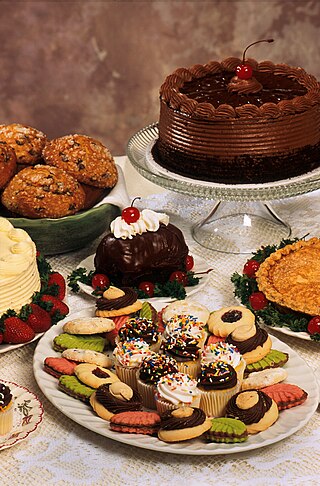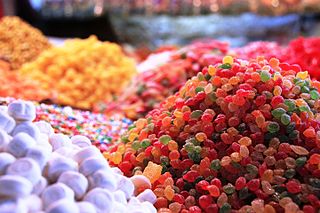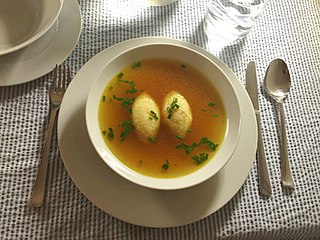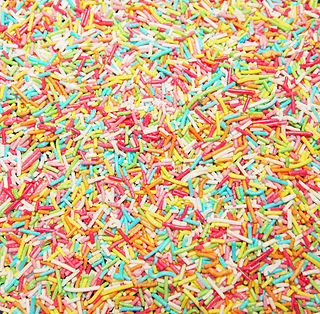
Dessert is a course that concludes a meal. The course consists of sweet foods, such as cake, biscuit, ice cream and possibly a beverage such as dessert wine and liqueur. Some cultures sweeten foods that are more commonly savory to create desserts. In some parts of the world there is no tradition of a dessert course to conclude a meal.

Mexican cuisine consists of the cooking cuisines and traditions of the modern country of Mexico. Its earliest roots lie in Mesoamerican cuisine. Mexican cuisine ingredients and methods begin with the first agricultural communities such as the Olmec and Maya who domesticated maize, created the standard process of nixtamalization, and established their foodways. Successive waves of other Mesoamerican groups brought with them their cooking methods. These included: the Teotihuacanos, Toltec, Huastec, Zapotec, Mixtec, Otomi, Purépecha, Totonac, Mazatec, Mazahua, and Nahua. With the Mexica formation of the multi-ethnic Triple Alliance, culinary foodways became infused.

Confectionery is the art of making confections, or sweet foods. Confections are items that are rich in sugar and carbohydrates although exact definitions are difficult. In general, however, confections are divided into two broad and somewhat overlapping categories: bakers' confections and sugar confections.

Cake is a flour confection made from flour, sugar, and other ingredients and is usually baked. In their oldest forms, cakes were modifications of bread, but cakes now cover a wide range of preparations that can be simple or elaborate and which share features with desserts such as pastries, meringues, custards, and pies.

Candy, alternatively called sweets or lollies, is a confection that features sugar as a principal ingredient. The category, also called sugar confectionery, encompasses any sweet confection, including chocolate, chewing gum, and sugar candy. Vegetables, fruit, or nuts which have been glazed and coated with sugar are said to be candied.

Hungarian or Magyar cuisine is the cuisine characteristic of the nation of Hungary, and its primary ethnic group, the Magyars. Hungarian cuisine has been described as being the spiciest cuisine in Europe. This can largely be attributed to the use of their piquant native spice, Hungarian paprika, in many of their dishes. A mild version of the spice, Hungarian sweet paprika, is commonly used as an alternative. Traditional Hungarian dishes are primarily based on meats, seasonal vegetables, fruits, bread, and dairy products.

Belgian cuisine is widely varied among regions, while also reflecting the cuisines of neighbouring France, Germany and the Netherlands. It is characterised by the combination of French cuisine with the more hearty Flemish fare. Outside the country, Belgium is best known for its chocolate, waffles, fries and beer.

Danish cuisine originated from the peasant population's own local produce and was enhanced by cooking techniques developed in the late 19th century and the wider availability of goods during and after the Industrial Revolution. Open sandwiches, known as smørrebrød, which in their basic form are the usual fare for lunch, can be considered a national speciality when prepared and garnished with a variety of ingredients. Hot meals are typically prepared with meat or fish. Substantial meat and fish dishes includes flæskesteg and kogt torsk with mustard sauce and trimmings. Ground meats became widespread during the industrial revolution and traditional dishes that are still popular include frikadeller, karbonader and medisterpølse. Denmark is known for its Carlsberg and Tuborg beers and for its akvavit and bitters, but amongst the Danes themselves imported wine has gained steadily in popularity since the 1960s.

Austrian cuisine consists of many different local or regional cuisines. In addition to Viennese cuisine, which is predominantly based on the cooking traditions of the Habsburg Empire, there are independent regional traditions in all the states of Austria.

Sprinkles are small pieces of confectionery used as an often colorful decoration or to add texture to desserts such as brownies, cupcakes, doughnuts or ice cream. The tiny candies are produced in a variety of colors and are generally used as a topping or a decorative element. The Dictionary of American Regional English defines them as "tiny balls or rod-shaped bits of candy used as a topping for ice-cream, cakes and other."

Dutch cuisine is formed from the cooking traditions and practices of the Netherlands. The country's cuisine is shaped by its location on the fertile Rhine–Meuse–Scheldt delta at the North Sea, giving rise to fishing, farming, and overseas trade. Due to the availability of water and flat grassland, the Dutch diet contains many dairy products such as butter and cheese. The court of the Burgundian Netherlands enriched the cuisine of the elite in the Low Countries in the 15th and 16th century, so did in the 17th and 18th century colonial trade, when the Dutch ruled the spice trade, played a pivotal role in the global spread of coffee, and started the modern era of chocolate, by developing the Dutch process chocolate.

A tea party is a social gathering event held in the afternoon. For hundreds of years, many societies have cherished drinking tea with companions at noon. Tea parties are considered for formal business meetings, social celebrations or just as an afternoon refreshment.

Death by Chocolate is a colloquial descriptive or marketing term for various cakes and desserts that feature chocolate, especially dark chocolate or cocoa, as the primary ingredient. The phrase is trademarked in some countries, and the dessert is a signature dish of Bennigan's restaurants in the United States.

A party favor is a small gift given to the guests at a party as a gesture of thanks for their attendance, a memento of the occasion, or simply for fun.
The following outline is provided as an overview of and topical guide to chocolate:

A candy bar is a type of candy that is in the shape of a bar. The most common type of candy bar is the chocolate bar, including both bars made of solid chocolate and combination candy bars, which are candy bars that combine chocolate with other ingredients, such as nuts, caramel, nougat, or wafers.

This is a categorically organized list of foods. Food is any substance consumed to provide nutritional support for the body. It is produced either by plants, animals, or fungi, and contains essential nutrients, such as carbohydrates, fats, proteins, vitamins, and minerals. The substance is ingested by an organism and assimilated by the organism's cells in an effort to produce energy, maintain life, or stimulate growth.
Porcelain services that were produced during the Rococo period, roughly aligning with the reign of Louis XV of France from 1715 to 1774, included a variety of shapes or molds of dishes for use during savory and sweetmeat courses. These included plates, platters, tureens, sauce cups, cake stands, epergnes, wine coolers, and ice cream coolers, as well as porcelain molds not designed for food services such as etagere vases, flower vases, potpourri vases, toilet set bowls, and plaques inlaid into furniture. Two of the most famous manufacturers of rococo porcelain services in Europe were the Manufacture Nationale de Sevres in France and Meissen Porcelain in Germany. While Sevres worked almost exclusively in soft paste porcelain during the rococo period, which was composed of a translucent mixture of clay, glass, and minerals such as feldspar and quartz, Meissen was the first European porcelain manufactory to produce hard paste wares, which were modeled after earlier Asian imported porcelain which contained clay, minerals, and kaolin, which allowed the clay to survive much higher firing temperatures in the kiln, producing more opaque and stronger completed dishes than were previously available domestically.
















